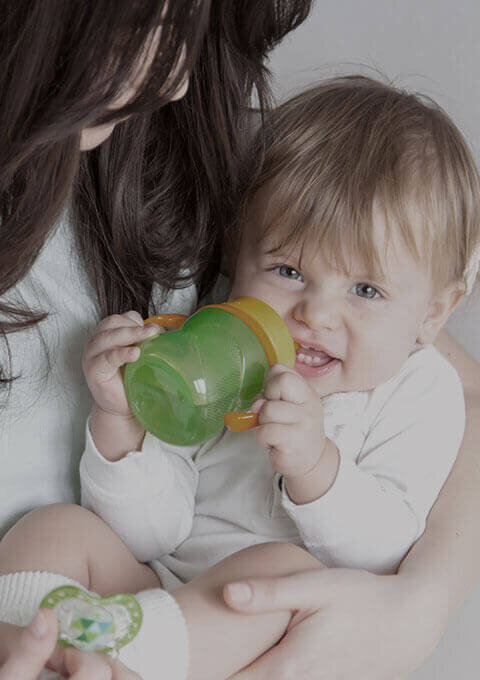When and how should you start baby's drinking training? This is a very individual issue. There are children who will grab a cup early to mimic adults, and quickly learn how to drink from it. Others, having a stronger bond with a bottle, will not relinquish it so willingly.
Drinking from a cup has many advantages. It develops correct breathing and swallowing patterns, and prevents caries, because the baby does not hold a bottle teat in his mouth all the time. At the beginning, an ideal solution is to develop a pattern in which milk is drank from a bottle, and other liquids - juices, water - from a cup. Gradually, the bottle is replaced by the cup. It will certainly not be achieved at one go, so you need to be patient.
When the baby can sit up and has already started his spoon training, you can make first attempts at drinking from the cup. In some babies this can be 6th month of life, other will learn that only when they are over a year. The best thing is to start the drinking training with a non-spill cup. It is safe, the child will not choke and he will control the drink flow himself. And you will not have to change his clothes every two minutes. When the child is more apt at it, you can take out a valve controlling the flow. Later you can try a flask, to end with a normal cup.
Never scream at the child if he is unsucessful. Parting with a bottle or a breast and learning a new skill is stressful enough, after all, you do not want to discourage the child. Do not force him to swallow any liquid. He must also always sit, he should not be in a semi-inclined position, as then he can choke. Particularly during the first stage of learning, never leave the child alone, but be around and control the situation. It is good to have several bibs at hand.
There is a wide selection of joyful patterns and shapes of cups available for children. This should encourage the child to reach for the cup. The best choice is always water, spring water in the case of infants. But you can start with small amounts of thick juice, so the child is more interested. Also, at the beginning the thick liquid can be safer for the baby.
Water is most recommended. The best thing is to get the baby acquainted with its taste as soon as possible. If the baby does not want to drink it, try to add a little bit of juice, a few drops squeezed from a lemon. Remember that juice is a kind of snack and should be given in moderation. Furthermore, when the child drinks juices, you cannot be sure whether he is really thirsty or he reaches for the juice because of its sweet taste. Occasionally, you can give the baby an infant tea, but you mustn't give him normal tea, coffee, sweet or carbonated drinks.
Water, juice, soft drink, compote? What should you give your baby to drink, and in what daily amounts? Which signs related to insufficient amount of drank fluids raise a red flag?
Infant gruels are a very important part of your baby's diet. They supply to the demanding body of your baby components necessary for his correct development, including calcium, iron, magnesium, and are supplemented with vitamins, ...
It is said that no child is born a poor eater. Each of us arrives into the world with a natural survival instinct, and this requires eating. However, if your baby has become a poor eater, here you will find some suggestions ...
There comes a moment when mum's breast alone is not enough. Here you can find tips when and how you should introduce new components into your baby's diet.
